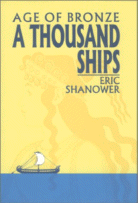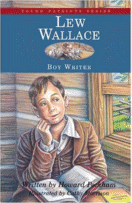Children's Book Reviews
Page One of TwoAge of Bronze: A Thousand Ships by Eric Shanower
Image Comics, July, 2001Hardcover, 223 pages
ISBN: 1582402213
Ages 10 and up
Ordering information:
Amazon.com
 A Thousand Ships is a graphic novel retelling the events that
led up to the Trojan War. It originally appeared in serial form
in the Age of Bronze comic book series in nine issues. A
Thousand Ships may be in graphic novel form, but it belongs
in serious libraries for several reasons. First, it is the result
of consultations with many of the leading scholars in the fields
of classical studies and archaeological digs. The bibliography
alone is extensive. Also included is a very helpful pronunciation
guide for all one hundred fifty one names that appear in the story.
Just as appreciated are the genealogical charts of both the
Achaeans and the Trojan royal family. A map of the area during
the late Bronze Age appears in the front of the book. The
author's essay in the Afterword section is also invaluable in
understanding the story line and probably should be read before
delving into the story. Drawings or cartoons of complicated story
lines are useful in identifying all the characters, as well as for
clarifying their points of view. For the reader who must mentally
sort out all of the plots and subplots complicated by unfamiliar
names and places, A Thousand Ships, is an excellent reference book.
A Thousand Ships is a graphic novel retelling the events that
led up to the Trojan War. It originally appeared in serial form
in the Age of Bronze comic book series in nine issues. A
Thousand Ships may be in graphic novel form, but it belongs
in serious libraries for several reasons. First, it is the result
of consultations with many of the leading scholars in the fields
of classical studies and archaeological digs. The bibliography
alone is extensive. Also included is a very helpful pronunciation
guide for all one hundred fifty one names that appear in the story.
Just as appreciated are the genealogical charts of both the
Achaeans and the Trojan royal family. A map of the area during
the late Bronze Age appears in the front of the book. The
author's essay in the Afterword section is also invaluable in
understanding the story line and probably should be read before
delving into the story. Drawings or cartoons of complicated story
lines are useful in identifying all the characters, as well as for
clarifying their points of view. For the reader who must mentally
sort out all of the plots and subplots complicated by unfamiliar
names and places, A Thousand Ships, is an excellent reference book.
Eric Shanower has given us a thrilling book presented in the graphic novel mode. Every important detail of the conflict to come is explored and illustrated in careful detail. As he points out in his Afterword, the costumes, hairstyles and racial types have all been faithfully recreated. The author had no desire to characterize the persons in the story as a bunch of people walking around in Greek temples wearing battle helmets. Instead, as closely as research could reveal, the Achaeans look different from the Trojans in costume, hairstyle and somewhat in features. Weapons of the period are also shown in detail, as are the ships which made up the fabled fleet. All of this will give the reader a great sense of the setting of the conflict to come and will provide an accurate insight into the reasons that would incite such a war. We are introduced to the handsome but impulsive and foolish Paris, the sly, tricky Odysseus and the confused Helen, along with the cuckolded Menelaus.
Although Eric Shanower has presented us with a graphic novel that will compel us to read it in one reading, and will clarify so many heretofore aspects of classical literature, this is very definitely not a book to buy for your ten year-old niece or nephew in hopes that they will now be grounded in the all-important classical literary themes. Mr. Shanower has written an earnest and honest rendition of Homer, and he has not shied away from the occasional promiscuous sexual adventures of the fabled Greeks. Sexual encounters and even the childbirth practices of Bronze Age Greeks are graphically illustrated. One can only hope that Mr. Shanower will pen a version of the same tale for those of more tender years. He has written for children before, and we can only hope that he will not ignore them in this endeavor of presenting the cultures that have so profoundly influence our lives every day.
--Sarah Reaves White
Lew Wallace: Boy Writer (Young Patriots Series) by Martha E. Schaaf, Illustrated by Cathy Morrison
Patria Press, April, 2001Hardcover, 112 pages
ISBN: 1882859057
Ages 9-12
Ordering information:
Amazon.com
 In the 1950's and 1960's, books known as the
Childhood of Famous Americans series were a well-respected
item on schoolroom and school library shelves. Not only were
stories of the childhoods of famous Americans like George
Washington and Abraham Lincoln in the group, but the stories
of lesser-known persons who achieved greatness in some form
were also included. These books meant a great deal to Florrie
Binford Kichler, who found character qualities that led to
greatness inspiring, so she has decided to republish these stories
as the Young Patriots series. This project will acquaint young
readers with many persons who, although not as famous as presidents,
actually contributed to this nation and to the world. Such a person
was Lew Wallace, a young man who grew up in Indiana and actually
wrote one of the most popular books of all time, Ben Hur.
In the 1950's and 1960's, books known as the
Childhood of Famous Americans series were a well-respected
item on schoolroom and school library shelves. Not only were
stories of the childhoods of famous Americans like George
Washington and Abraham Lincoln in the group, but the stories
of lesser-known persons who achieved greatness in some form
were also included. These books meant a great deal to Florrie
Binford Kichler, who found character qualities that led to
greatness inspiring, so she has decided to republish these stories
as the Young Patriots series. This project will acquaint young
readers with many persons who, although not as famous as presidents,
actually contributed to this nation and to the world. Such a person
was Lew Wallace, a young man who grew up in Indiana and actually
wrote one of the most popular books of all time, Ben Hur.
Lew Wallace certainly did not show much promise in his early years. Although he was descended from John Paul Jones of American naval fame and William Wallace, one of the Scottish Chiefs, Lew appeared more interested in drawing and going for a walk in the woods, or fishing. Although his father was a governor of Indiana, Lew was not a good student, especially when it came to mathematics. The story of Lew Wallace's misadventures in pursuit of an education evokes a time in education that will shock and amaze today's student. To learn how students were beaten for not learning, or humiliated by being placed in a girl's bonnet and being made to sit with the girls for not knowing arithmetic facts, will certainly explain well to students today how much getting an education has changed. Although students who read this story may long for the good old days when getting an education was neither rigid nor regulated, they will most certainly not want to experience a repeat of the beatings that went along with learning.
Students who read about Lew Wallace's youth will be shocked with quite a few things that were generally accepted in the nineteenth century. In the early years of the twenty-first century we do not really expect to lose family members to death, but this was a somewhat common occurrence when Lew Wallace was growing up. He lost a baby brother from scarlet fever, and his mother also later died of unknown causes. One could study law in the office of a lawyer and then practice. When Lew Wallace decides to join the militia to fight in the war against Mexico, he has to attract recruits and then he becomes its leader. The complicated processes to get things done that exist in today's world did not exist in the nineteenth century. Any student who reads this biography will learn a great deal about nineteenth century America, while finding out what makes a young person succeed. Students will enjoy this story for many reasons, but they are most likely to identify with Lew Wallace because the story ends while he is still quite young. Then his later accomplishments are simply listed on the last page.
Martha E. Schaaf has done an excellent job of presenting life as it really was in the nineteenth century in the smaller towns, and in the Midwest in general. She fills the pages with the dangers of runaway horses, as well a the threat of unhappy Indian tribes. The relatively untrained groups that formed the country's first armies look haphazard to the modern reader. The school supplies and dearth of books make us marvel that anyone in those times ever received anything but an unfocused education. Yet these people built a nation which we have inherited in good condition. All of these facts have been skillfully woven into the story of the childhood of one of the nation's most widely read writers. Any student who reads this biography will have learned a great deal of history, as well as what it takes to succeed.
--Sarah Reaves White
Children's Book Reviews
Page One | Page Two
Return to the October-November 2001 issue of The IWJ.
More from Writers Write
